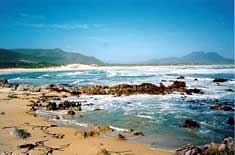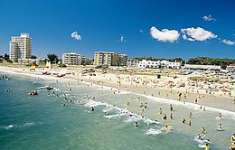Eighteen South African beaches have been awarded international Blue Flag status for excelling in safety, cleanliness, the provision of amenities and setting and maintaining environmental standards.
 Blue Flag gives local and foreign visitors the knowledge that their beaches are clean, environmentally sound and adhere to international safety and other tourist standards.
Blue Flag gives local and foreign visitors the knowledge that their beaches are clean, environmentally sound and adhere to international safety and other tourist standards.
When South Africa joined the campaign in 2001 as the first country outside Europe to participate, Blue Flag began to grow into a truly international campaign.
The Blue Flag is given to beaches that meet 14 criteria spanning three aspects of coastal management: water quality, environmental education and information, and safety and services, which include excellent life-saving standards, top-rate parking and sparkling ablution facilities.
Local authorities report a number of spin-offs from being awarded Blue Flag status, including an increase in visitors, improved behaviour on the part of beach-goers, property prices rising for homes near Blue Flag beaches - and visitors enjoying a well cared-for and managed beach.
South Africa's Blue Flag beaches 2007:
EASTERN CAPE
KWAZULU-NATAL
WESTERN CAPE
According to the Department of Environmental Affairs and Tourism, a further 21 SA beaches are piloting the Blue Flag Programme with the aim of achieving full accreditation in 2008 or 2009.
"The growth in the number of Blue Flag beaches augurs well for the future, and especially for visitors coming to South Africa for the World Cup in 2010," the department says.
"Blue Flag beaches along the KwaZulu-Natal coastline, with their warm Indian Ocean waters and 365-day-a-year swimming conditions, will be ideal places for soccer fans to chill out and relax."
The Blue Flag is awarded for one year only. Twenty South African beaches were awarded Blue Flag status in 2006, 20 in 2005, 14 in 2004, eight in 2003, eight in 2002, and four in 2001.
SA's Blue Flag beaches 2001-2006:
EASTERN CAPE
KWAZULU-NATAL
WESTERN CAPE
The Blue Flag was born in France in 1985 where the first French coastal municipalities were awarded the Blue Flag on the basis of criteria covering sewage treatment and bathing water quality
The concept has grown from there to encompass other required qualities and there are now over 2 600 Blue Flag beaches and 600 Blue Flag marinas around the world.
Blue Flag is managed in South Africa by the Wildlife and Environment Society of South Africa, in partnership with the Department of Environmental Affairs and Tourism and participating coastal authorities under the department's Coast Care programme.
Coast Care gives financial and technical help for coastal development projects aimed mostly at poor communities, and offers education, training and research services.
Article last updated: November 2007
SAinfo reporter
|










